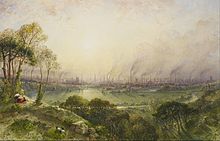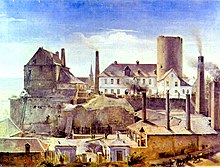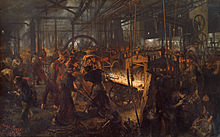Industrial painting

As industrial painting is painting called, the industry represents. It is part of the industrial culture .
history






In the course of industrialization , industrial architectures , industrial plants and industrial landscapes emerged, which visual artists discovered and developed as subjects for landscape , genre , interior , architecture and vedute painting . The people working in industry, the industrial worker and his working life, were also treated artistically by them. These representations form an essential part of the category of images on the subject of work and are considered to be a visual expression of modernity . Their number rose sharply in the course of the 19th century.
An early example of an industrial painting is the picture La Salpêtrière executed in gouache , which the French painter Louis Jean-Jacques Durameau (1733–1799) created in 1765 during a study visit to Rome from work in a saltpeter factory. When Denis Diderot saw this picture in the Salon de Paris in 1767, he was deeply impressed by the novel object and its execution. Around the same time, the painter Joseph Wright of Derby , who was a contemporary witness of the Industrial Revolution in England, began to deal with industrial pictorial subjects. The painting The Blacksmith's Shop (1771) is considered to be an important painting from this phase . The Swede Pehr Hilleström surpassed all his contemporaries in 124 identified paintings of copper and iron mines, metal and glass works, foundries, forges and anchor factories. Another painter who raised the emerging industry at the end of the 18th century, but also the contrast between the entrepreneurial class and the working class, to the subject of the picture was Léonard Defrance from Liège .
In the course of the 19th century there were many goals for industrial painters. Particularly noteworthy is industrial painting as a representation of the performance of a company and its products. So many industrial paintings were commissioned , for example for the representative design and interior decoration of administrative buildings of the company as well as for advertising catalogs, company brochures, commemorative publications and other publications. Industry pictures found their way into the commercial art and have been on industrial and commercial exhibitions shown, and in particular the great world exhibitions that have been organized since the mid-19th century. Therefore industrialists began to specifically select, promote and employ industrial painters. A well-known commissioned work that originated in Germany during the early days and became an icon of high industrialization in Germany was the painting Das Eisenstahlwerk by Adolph von Menzel . At about the same time, the picture cycle Life Story of a Locomotive was created , which Paul Meyerheim created for the industrialist Albert Borsig . At the end of the 19th century, engineering museums also began commissioning and exhibiting industrial painting.
Like other genres of painting, industrial painting also went through different stylistic epochs. Her painters followed different currents, conceptions of art, techniques and subjects. In the painting of Romanticism and Historicism, they used industrial motifs to indicate the disturbed relationship between man and nature or the arrival of a new social and economic order. Later, the painters' interest turned to social criticism and the representation of hard working and living conditions. At the same time there were industrial painters who idealized or heroized industry and its actors . At the turn of the 19th and 20th centuries, large-format bird's-eye views of industrial complexes came into fashion. Industrial architecture, landscapes and working environments were also preferred themes in New Objectivity painting . Industrial motifs also had a high priority in socialist realism . As a medium of fine art, representation, representation and advertising, industrial painting was largely replaced by industrial photography in the course of the 20th century .
Industrial painter






- Thomas Pollock Anshutz (1851-1912)
- Hans Baluschek (1870-1935)
- Walter Bernstein (1901–1981)
- Karl Eduard Biermann (1803-1892)
- Stefan Bircheneder (* 1974)
- Carl Blechen (1798-1840)
- Konstantin Fjodorowitsch Bogajewski (1872–1943)
- Otto Bollhagen (1861-1924)
- François Bonhommé (1809-1881)
- Emil Bott (? -1908)
- Eugen Bracht (1842–1921)
- Wilhelm Brandenberg (1889–1975)
- Alexander Calvelli (* 1963)
- Adrien Canelle (1819–1874)
- Hubert Cramer-Berke (1886–?)
- Terence Cuneo (1907-1996)
- Léonard Defrance (1735-1805)
- Gustav Deppe (1913–1999)
- Oskar Detering (1872-1943)
- Louis Jean-Jacques Durameau (1733–1799)
- Georg Fritz (1884–1967)
- Fritz Gärtner (1882–1958)
- Richard Gessner (1894–1989)
- Carl Geyling (1814-1880)
- Vincent van Gogh (1853-1890)
- Thomas Grochowiak (1914–2012)
- Carl Grossberg (1894-1940)
- Ferdinand Gueldry (1858-1945)
- Herman Heijenbrock (1871-1948)
- Ernst Hesmert (? - after 1911)
- Ludwig Heupel-Siegen (1864–1945)
- Pehr Hilleström (1732-1816)
- Friedrich Kallmorgen (1856–1924)
- Arthur Kampf (1864-1950)
- Nikolai Alexejewitsch Kassatkin (1859–1930)
- Georg Kaulbach (1866–1945)
- Paul Kirnig (1891–1955)
- Heinrich Kley (1863–1945)
- Henry Farny (1847-1916)
- Will Klinger-Franken (1909–1986)
- Ernst Knippel (1811–1900)
- Robert Koehler (1850-1917)
- Armand Kohl (1845–?)
- Wilhelm Kranz (1853–1930)
- Peder Severin Krøyer (1851–1909)
- John Lavery (1856-1941)
- Joseph-Fortuné-Séraphin Layraud (1833–1913)
- Paul Lehmann-Brauns (1885–1970)
- Laurence Stephen Lowry (1887-1976)
- Philipp Jakob Loutherbourg the Younger (1740–1812)
- Louis Majorelle (1859-1926)
- Reginald Marsh (1898-1954)
- Anton Marussig (1868–1925)
- Adolphe Maugendre (1809–1895)
- Adolph von Menzel (1815–1905)
- Erich Mercker (1891–1973)
- Constantin Meunier (1831–1905)
- Paul Friedrich Meyerheim (1842–1915)
- Anders Montan (1845-1917)
- Markus Pernhart (1824–1871)
- Hermann Peters (1886–1970)
- Hermann Emil Pohle (1863–1914)
- Carl Theodor Protzen (1887–1956)
- Alfred Rethel (1816-1859)
- Diego Rivera (1886–1957)
- Wolf Röhricht (1886–1953)
- Alfred Philippe Roll (1846-1919)
- Richard Rothgießer (1873–1950)
- Leonhard Sandrock (1867–1945)
- Jakob Scheiner (1820–1911)
- Wilhelm Scheiner (1852–1922)
- Alexander Scherban (1886–1964)
- Max Schewe (1896–1951)
- Robert Schneider (* 1944)
- Carl Schütz (1745–1800)
- William Bell Scott (1811-1890)
- Paul Anton Skerl (1787-1852)
- Antonín Slavíček (1870-1910)
- Robert Friedrich Stieler (1847–1908)
- Franz Trenk (1899–1960)
- Hans Dieter Tylle (* 1954)
- Günter Voglsamer (1918-2004)
- Cornelis de Waal (1881-1946)
- Cornelius Wagner (1870-1956)
- Ludwig Waldschmidt (1886–1957)
- Matthäus Friedrich Weber (1765-1811)
- Jakob Weeser-Krell (1843–1903)
- Benedikt Werkstätter (1708–1772)
- August von Wille (1828–1887)
- Toni Wolter (1875-1929)
- Adolf Wriggers (1896–1984)
- Joseph Wright of Derby (1734-1797)
- Gustav Wunderwald (1882–1945)
- William Wyld (1809-1889)
literature
- Sabine Beneke, Hans Ottomeyer (Ed.): The second creation. Images of the industrial world from the 18th century to the present . Berlin 2002, ISBN 978-3-93235-362-8 .
- Christoph Bertsch: Industrial revolution in the fine arts of the 19th century . In: Dietmar Guderian (Ed.): Technology and Art . Springer, Berlin 1994, ISBN 978-3-642-95793-2 , pp. 233-261.
- Beate Ines Ermacora: The industrial image in painting and graphics of the 19th century in Austria . Dissertation, Innsbruck 1987.
- Hans-Peter Hilger: Beginnings of industrial painting in Germany . In: The cut. Magazine for art and culture in mining . Volume 12, No. 4, Bochum 1960, pp. 10-14.
- Eva A. Mayring: Images of technology, science and industry. An inventory catalog of the Deutsches Museum Munich . Munich 2008, ISBN 978-3-93883-228-8 .
- Sung-Kook Park: Studies of Industrial Motifs in Romantic Painting . Marburg 2004, ISBN 978-3-8288-8727-5 .
- Hedwig Schmücker: The industrial motif in German painting of the 19th and 20th centuries . Dissertation, Münster 1930.
- Klaus Türk (Hrsg.): Work and industry in the fine arts. Contributions to an interdisciplinary symposium . Franz Steiner Verlag, Stuttgart 1997, ISBN 3-515-07139-3 .
- Agnes Waldstein : The industrial picture. About becoming a new art . Berlin 1929.
Web links
- Dominica Capozucca-Jachnow, Jörg Meißner, Maike Steinkamp: artist biographies , website for the exhibition The Second Creation: Images of the Industrial World from the 18th Century to the Present (2002) in the portal dhm.de ( German Historical Museum )
Individual evidence
- ↑ La Salpêtrière , website in the kunstkopie.de portal , accessed on November 3, 2016
- ↑ Christine Hoffmeister: European industrial paintings between Rococo and Romanticism . In: Klaus Türk (Ed.), P. 27
- ↑ Christine Hoffmeister, p. 31
- ^ Françoise Dehousse, Maïté Pacco, Maurice Pauchen: Léonard Defrance. L'œuvre pains. Editions du Perron et Eugène Wahle, Liège 1985, ISBN 2-87011-099-5 .



